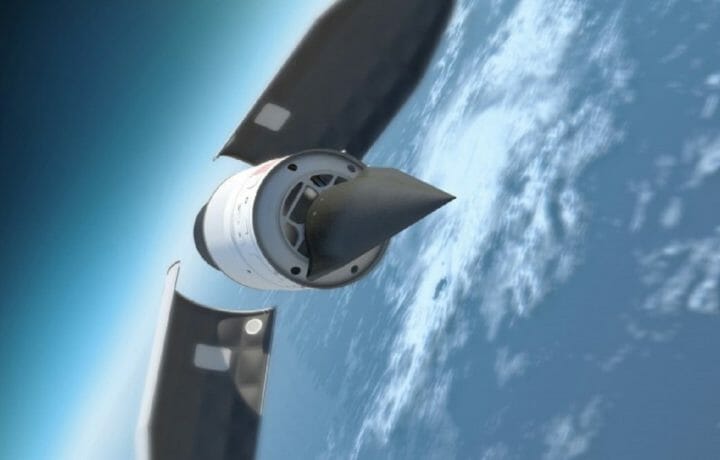The newest branch of the United States military, the United States Space Force, could soon help defend against threats from hypersonic missiles. The service announced that it has selected Millennium Space Systems along with Raytheon to design sensors that could track the extremely high-speed missiles from medium Earth orbit.
If this project proves successful it could add to the existing layered missile defense system that currently includes ground, sea-based and space sensors. The Defense Department’s Space Development Agency, the Missile Defense Agency and the Space Force have engaged in efforts to develop a multi-orbit network of space sensors that could detect and track both ballistic and hypersonic missiles.
Hypersonic weapons have been a serious threat, as they can fly in excess of Mach 5 – or five times the speed of sound – and are also able to maneuver in flight with computerized precision, which could make it difficult to counter. Additionally, a hypersonic missile’s speed and force are so significant that the weapon could inflict significant damage from its “kinetic” impact and wouldn’t need explosives. However, the missiles could still be fitted with nuclear warheads, making them a very dangerous threat. Tracking these as early as possible would be crucial in stopping the missile from hitting a target.
Space Force will be investing billions of dollars into a new constellation of the Next-Generation Overhead Infrared (OPIR) geostationary and polar-orbiting satellites. The Northrop Grumman system will help provide a global early warning of missile launches.
Space Force and Space X
The sixth and newest branch of the U.S. military has also completed its first successful launch with a privately-owned SpaceX reusable rockets. Earlier this month the Space Force’s Space and Missile Systems Center (SMC) completed the launch of an advanced GPS satellite – the 19th launch of the year from the “Space Coast’s” Cape Canaveral Space Force Station, Space Launch Complex-40.
A Lockheed Martin-built satellite was carried to orbit aboard a Space Exploration Technologies Corporation (SpaceX) Falcon 9 launch vehicle, which had been previously used in a GPS launch last November. It marked the first National Security Space Launch to use a reusable booster. The 227-foot-tall Falcon 9 is SpaceX’s primary rocket, boasting more than 1.5 million pounds of thrust at liftoff.
“The launch of GPS III SV05 is a testament to SMC’s ability to rapidly and safely deliver new capabilities on orbit. This successful launch occurred just seven months after SV04 and the team worked concurrent operations between both SVs during the dynamic situation presented by COVID-19,” said Cordell DeLaPena, Jr., U.S. Space Force program executive officer for SMC’s Space Production Corps. “At SMC, we are proud to deliver our fifth GPS III satellite and will continue to operate at an accelerated pace to meet the demands of our users.”
The GPS III SV05 is the 24th Military Code (M-Code) satellite to join the current GPS constellation comprised of 31-operational spacecraft, the last required for M-Code Full Operational Capability. These spacecraft are a replacement for the 31 GPS satellites that are currently operating in orbit.
“This inaugural flight demonstrates the power of applying the Government’s proven Mission Assurance process with industry’s innovative launch systems,” added Col. Robert Bongiovi, SMC Launch Enterprise director. “I couldn’t be more proud of how our SMC team and industry partners continue to innovate with every launch.”
The Pentagon had awarded SpaceX with five of the six GPS III satellite launch contracts to date, while the GPS III SV02 mission launched was conducted by competitor United Launch Alliance. It is the rocket-building joint venture of Boeing and Lockheed Martin.
Two additional GPS missions are already scheduled to fly on SpaceX rockets sometime next year, and both will launch atop refurbished rockets. The GPSIII reuse/recovery missions are saving the government a total of $64.5 million.
To the Moon and Beyond
It won’t be just satellites in Earth’s orbit that will comprise the domain of the Space Force. According to a new report published by the Air Force Research Laboratory’s Space Vehicles Directorate – titled “A Primer on Cislunar Space” – the Space Force could eventually be charged with taking the lead on operations around the moon and even beyond.
“As NASA’s human presence extends beyond ISS to the lunar surface, cislunar, and interplanetary destinations, and as USSF organizes, trains, and equips to provide the resources necessary to protect and defend vital U.S. interests in and beyond Earth-orbit, new collaborations will be key to operating safely and securely on these distant frontiers,” the report noted.
As SpaceNews.com reported, cislunar space generally is defined as the region that contains the Earth, moon, and Lagrange points where spacecraft may be deployed in the future should a cislunar economy emerges.
“Operating spacecraft beyond geosynchronous Earth orbit poses unique challenges,” said Col Eric Felt, director of the AFRL’s Space Vehicles Directorate, via a statement. “As commerce extends to the moon and beyond, it is vital we understand and solve those unique challenges so that we can provide space domain awareness and security.”
The laboratory has led the efforts into research in cislunar space; there remains multiple concerns including the developing of technologies that could be utilized for surveillance, navigation and communications. Last year Space Force and NASA signed a cooperative agreement to collaborate on future cislunar space research and technology.




